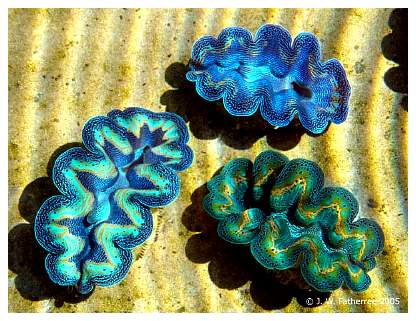|
Fatherree, J. 2006. Giant Clams in the Sea and the Aquarium. Liquid Medium. Tampa, FL. 227pp. ISBN 0-9786194-0-4.
Of the multitude of organisms we keep in our reef tanks, tridacnid clams are one that many people develop a fascination for that can sometimes border on the fanatical. They often are referred to colloquially as “giant clams” due to the large size some species attain. The real attention getter for most aquarists, however, is not their large size but the vivid array of colors and patterns exhibited in the mantle of these clams as seen in the photo above. Like other animals often kept in aquaria, a lot of misinformation and myth can be found about them, as well as good solid information for those who choose to look for it. In his book, Giant Clams in the Sea and the Aquarium, James Fatherree gathers the most up-to-date scientific and anecdotal information available. Using a litany of sources, including scientific literature, clam farmers, scientists and industry professionals, James has done an excellent job of pulling the information together and presenting it in an easy to read fashion. James Fatherree has previously published many articles, pictures and several books, and his background as a hobbyist and aquarium industry professional, ranging from a diver/collector to a retail store manager and everything in between, gives him a unique outlook to write about clams.
 |
|
Photo courtesy of James Fatherree. |
Giant Clams in the Sea and the Aquarium is divided into six chapters. The first chapter covers basic tridacnid biology and includes information ranging from shell morphology of the various species to the coloration of their mantle. Some might find it surprising, but not only do tridacnid clams have eyes, their eyes even contain zooxanthellae. I found the second chapter of particular interest, as it dispels some common notions about tridacnid nutrition. It seems that even small clams (except Hippopus), as well as large clams of all species, get all of their carbon/energy needs via their zooxanthellae under optimum conditions. More importantly to the aquarist is the fact that tridacnid clams have partially degenerated and small digestive systems, so while they can and do eat, don’t expect them to be able to eat enough to make up for poor aquarium lighting. The biggest surprise, however, is what they can eat. They don’t eat just phytoplankton, but can also eat zooplankton and detritus filtered from the water column. Chapter three provides detailed information about the various species. This is a particularly important chapter to read before attempting to a buy a clam. Information about depth and ecological niche is just as important as sizes the clams grow to, and it’s all here to give aquarists important clues about these clams' lighting requirements and placement in the tank. Click here for an Adobe Acrobat sample of chapter three. The fourth chapter delves into collecting, farming and shipping. As an aquaculturist, I found the section on clam farming quite interesting, and it included enough information
|
Chapters:
| Chapter 1 |
Tridacnid Biology Basics |
| Chapter 2 |
Tridacnid Nutrition |
| Chapter 3 |
The Tridacnid Species |
| Chapter 4 |
Collecting, Farming, and Shipping Tridacnids |
| Chapter 5 |
The Acquisition and Care of Tridacnids |
| Chapter 6 |
Tridacnid Troubles |
|
to start me wondering how I could sneak some clam culturing into the fisheries that I lab run. When it comes to acquiring and caring for your clams in the aquarium, chapter five delves into interesting topics such as commensal shrimp, water quality, lighting and what to look for when purchasing a clam. As many regulars of the various aquarium forums know, lighting can be a particularly contentious subject. Fatherree does an admirable job of sorting through this topic and gives some very solid advice about planning your lighting scheme to allow your clams to thrive. The sixth, and final, chapter is titled “Tridacnid Troubles.” This chapter covers pests and ailments such as the pyramidellid snails, bleaching, disease issues and what to do should you come across any of these problems, as well as techniques for preventing some of them. For those who wish to look into a specific subject even deeper, or who are just looking to see where James got his information, an extensive list of references is included. Most of these are easy to find either online or through your local university's library.
|
Photos courtesy of James Fatherree. |
It has become somewhat common for authors of aquarium books to self-publish, and it seems that many of the better books available have come to us in this manner. Giant Clams in the Sea and the Aquarium is no exception. James Fatherree self-published this book under the publisher's name Liquid Medium (www.liquid-medium.com), and distributes the book wholesale with a recommended retail price of $39.95. As a marine biologist and long time aquarium industry professional, I found this book very informative and easy to read and understand, with no need for a scientific background. If you’re interested in keeping tridacnids in your reef tank, or are just plain interested in tridacnid clams, this book is a must have.
|
Photos courtesy of James Fatherree. |
|

